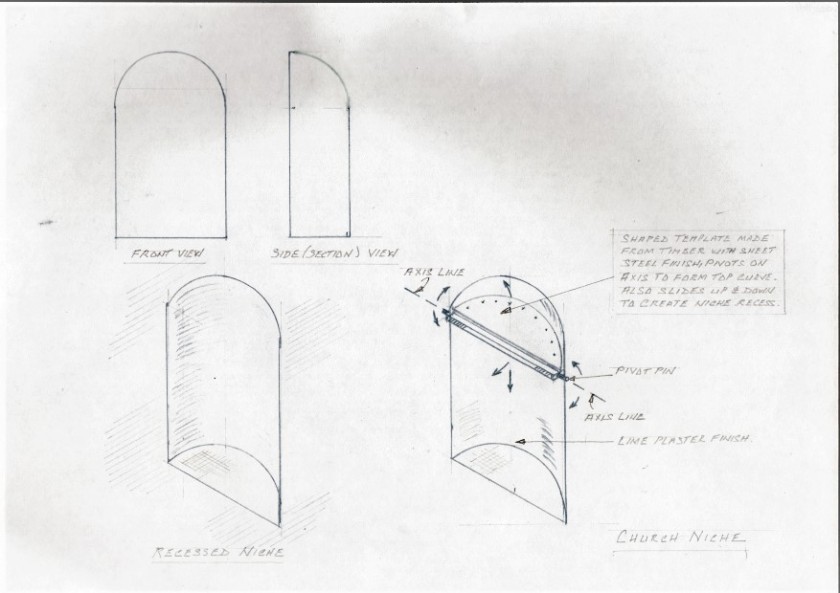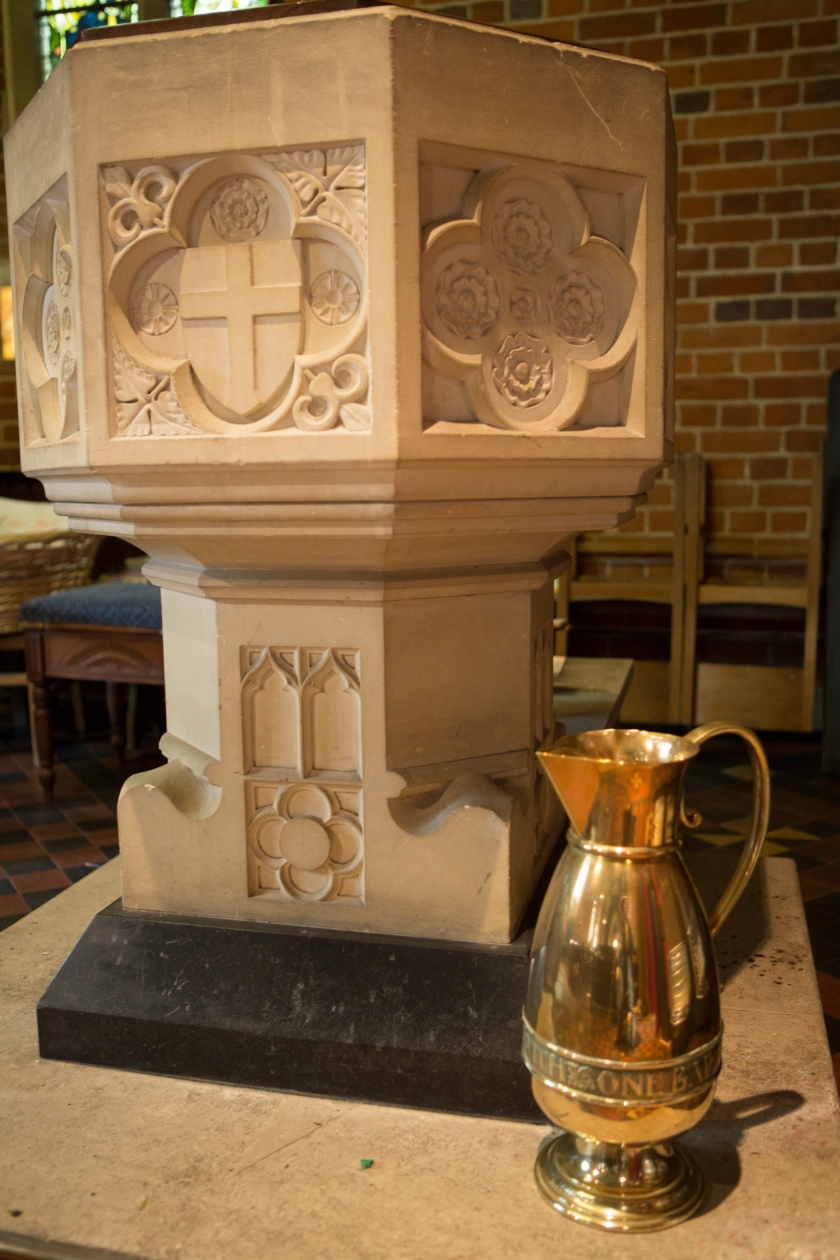Valley End, like many churches, is proud of the art and design it holds. Features such as the stained glass windows were beautifully made by professional firms.
But it also has other things, made by people with local connections. These have special ties to the church and the community, and deserve to be remembered.
The Piscina.
In 1957 Valley End parish was joined to Chobham, and the Rev. Roney Ackworth was the vicar. He planned some changes to the church fabric. One of his ideas was to add a piscina, or a niche in which to wash the Communion vessels during the service. He persuaded Mike Lee to do it.
Mike was 21, and had just finished his apprenticeship as a plasterer. He already knew Valley End. (On one of his earliest jobs as an apprentice he had been in a team working on a house opposite the church. They were using wooden scaffolding, and every morning it was Mike’s task to climb up and wet the poles, so that they would swell and hold the metal bonds tightly.)
There was already a square opening beside the altar. Mike had to convert this into the piscina. He didn’t need to cut the bricks away, or add the stone sill, which was cut and fitted by another workman.

Design for template. (With thanks to Tony Fraser.)

There is a mystery about our piscina. Where does the water go after the vessels are washed? One belief is that it should feed back directly into the soil, as there might be traces of consecrated wafers and wine, which is considered too precious to go into a waste system – not that there is any chance of that at Valley End, which is not on main drainage.
St. Saviour’s has it’s own solution to the problem. The piscina has a small hole for the water, but no pipes. It is left to evaporate by itself.
The Font.
“A woman must have a thorough knowledge of music, singing, drawing, dancing…” (Austen, “Pride and Prejudice.”) Well brought up Victorian women were taught to play a little music, or to draw.
Working with a pencil or watercolours is one thing. But wielding a mallet and carving stone is another. A sculptor needs specialist equipment, space, and training. A Victorian woman sculptor would need to come from an unusual and supportive family.

The font at St. Saviour’s. (Image courtesy of David Fettes.)
Meriel Leicester Warren, Julia Seymour Bathurst’s daughter in law, did. Her family was unusually artistic and creative. The library at Tabley House, her childhood home, had books on art, literature and music as well as sketch books and scrapbooks.
Her grandfather, Sir John Leicester, 1st Lord de Tabley, not only inherited family paintings, and made them the foundation of a major art collection, but was a patron of English artists. He also painted himself, and went sketching with Turner, one of the artists he commissioned. He was deeply offended when Turner then billed him for lessons.
George Warren, her father, the 2nd Baron de Tabley, inherited his father’s artistic skills. When he ordered alterations to Tabley House it seems that he was his own architect, although he engaged Robert Curzon to provide the working drawings.
Meriel was one of 6 children, of whom 5 survived. Her brother John, the 3rd Baron de Tabley, was a writer and poet; her sister Eleanor, (Eleanor Leighton Warren) painted. Her youngest sister, Margaret Cowell-Stepney, was a diarist and letter writer. Eleanor’s daughter, Barbara Sotheby, became a painter and photographer.
Meriel herself was the sculptor. She carved the reredos in St. Peter’s Church, Tabley, and her sister Eleanor painted it.
There is another example of her work in St. Saviour’s, Valley End. When Julia built the church, Meriel carved the font as her contribution. She was obviously a skilled sculptor, and must have been trained, and produced other work. Sadly, these are the only two items that can be traced.

Plaque on the font at St. Saviour’s. (Image by David Fettes.)
The font is still used, 150 years after it was installed. Meriel herself lies nearby in St. Saviour’s churchyard. She died 12 days after giving birth to her 3rd son Allen Benjamin, and is buried next to one of her babies who was born and died on the 31st December 1870.
The Window.
Many people enjoy doing art as a hobby; they learn painting, drawing – or maybe glass engraving.
Among the glass at the church there is a simple window engraved with flowers, butterflies and birds; “The Lord God made them all.”

Engraved window by Les Little. (Image courtesy of David Fettes.)
This was made and given by Les Little, a parishioner, who had learned glass engraving. He was keen to share this skill, and made presents for his friends.
He was looking for a new project, and chose the church. He designed and engraved a window, and gave it to St. Saviour’s.
He and his wife Sylvia were very involved with the church. Sylvia used to play the organ. When she died, her husband gave silver to the church in her memory – a chalice and a ciborium to hold the wafers.
This means that the church has memorials to them both, which is fitting. “They thought so much of Valley End.”

Engraved window by Les Little. (Image courtesy of David Fettes.)
*****************************************
Sources.
Piscina.
With thanks to Mike Lee.
With thanks to Tony Fraser.
(See the article on “Running plaster mouldings” in Old-House Journal, Aug – Sept. 1984.)
Font.
Peter Cannon-Brookes. “Tabley House.” 1991.
“Paintings from Tabley; an exhibition of paintings from Tabley House; edited by Peter Cannon-Brookes.” The Heim Gallery, 10th October 1989 – 21st November 1989.
Window.
With thanks to Joan Weymouth.
